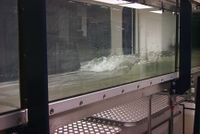Hydraulic Jump
- When the rapid change in the depth of flow is from a low stage to a high stage, the result is usually an abrupt rise of water surface. This local phenomenon is known as the hydraulic jump.
- Hydraulic jumps occur when the flow changes suddenly from supercritical to subcritical flow. This process is often accompanied by extreme turbulence and high energy losses. Hydraulic jumps often occur when there is a conflict between the upstream and downstream controls. It is the water equivalent of a sonic boom.
History
In 1818, the hydraulic jump was first investigated experimentally by Bidone, an Italian. This led Bélanger (1882) to distinguish between mild (subcritical) and steep (supercritical) slopes, since he had observed that in steep channels hydraulic jump is frequently produced by a barrier in originally uniform flow. Thereafter, abundant studies were made and the results were quoted by many writers. Outstanding contributors to our present knowledge about the hydraulic jump are Bresse (1860), Darcy and Bazin (1865), Ferriday and Merriman (1894), Gibson (1813), Kennison (1916), Woodward and Riegel-Beebe (1917), Koch and Carstanjen (1926), Lindquist (1927), Safranez (1927), Einwachter (1933), Smetana (1934), Bakhmeteff and Matzke (1936), Escande (1938), Citrini (1939), Nebbia (1940), Kindsvater (1944), Blaisdell (1948), Forste and Skrinde (1950), Rouse, Siao and Nagaratnam (1958) and many others.
It is the discontinuity in the water surface, characterised by a steep upward slope of the flow profile, broken throughout with violent turbulence. Hydraulic jump can also occur when the flow decelerates because the slope is not greater enough to maintain supercritical flow.
Images
References
- Open Channel Hydraulics by Chow
- FLUID MECHANICS with Engineering Applications
- https://ecourses.ou.edu/cgi-bin/ebook.cgi?doc=&topic=fl&chap_sec=10.3&page=theory
- http://www.ce.utexas.edu/prof/hodges/classes/Hydraulics.html
